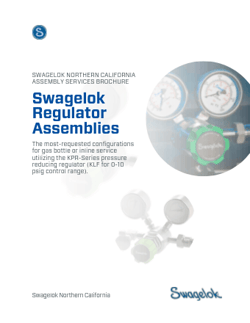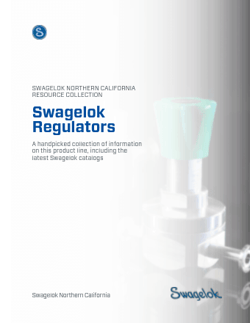Share this
Q&A with Eric Kayla: Answers to 5 pressure regulator questions
by Jeff Hopkins on 11/2/12 11:00 AM
Answers to 5 questions posed to regulator expert Eric Kayla. Plus, get his slides.
When we hosted the webinar "The Theory and Operation of Pressure-Reducing Regulators," participants sent in questions to Swagelok field engineer and webinar presenter Eric Kayla. Below is some of the material from the robust Q&A that followed Kayla's presentation.
Q: What happens if you oversize a regulator?"
A. If it's too big for the application, your poppet and seat will be too large, allowing too much flow. Every time that regulator opens, it will allow more flow than you expect. The regulator will do more work than it should need to. You'll see more fluctuations and spikes in your downstream pressure.
Q: What about if you undersize it?
A: Instead of having a seat and poppet too large, you'll have one too small. It will open as much as it can to let through as much flow as it can. You are probably going to operate closer to the choke flow range. You are also probably going to erode the seat faster than with a properly sized regulator.
Q: Discuss the difference between liquids and gasses in regulators.
A: Liquids are more straightforward because they are not compressible. Gasses are a little different, so there are different sizing methodologies. And if you are using a liquid with some particulates, it could increase wear on the seats over time.
Q: Does the supply-pressure effect happen with both liquids and gasses?
A: Yes. If we aren't changing anything on the loading force, our sensing mechanism will work to balance out against that loading force. If the inlet pressure force goes down, the only way to counterbalance it is an increase in outlet pressure force.
Q: Can you use a backpressure regulator for overpressure protection?
A: Yes, they can be used for overpressure protection. It probably requires a deeper discussion than a few sentences here. Some people choose to use a relief valve, but there are probably applications where it is more important to use a backpressure regulator. A relief valve is designed to stay closed, and to open only in an emergency. A back pressure regulator is designed as a dynamic component and will react constantly to keep upstream pressure constant.
Additional webinar Q&A
We will post again with more answers stemming from the briefing, including Kayla's answer to, "How does a two-stage regulator manage supply pressure effect?"
 Regulator assemblies
Regulator assemblies
Swagelok Northern California’s regulator assemblies provide the most-requested configurations for gas bottle or inline service utilizing the KPR-Series pressure reducing regulator (KLF for 0-10 psig control range). Click through for literature covering technical data for pressure, temperature, and flow, information on KPR regulator features, and ordering information.

Regulators catalogs +
We have regulators to fit almost any situation: back-pressure dome-loaded; back-pressure spring-loaded; pressure-reducing dome-loaded; pressure-reducing spring-loaded; high purity; sanitary; and tank-blanketing regulators.
Get all Swagelok regulators literature plus the Swagelok Pressure-Reducing Regulator Flow Curves Technical Bulletin.
More articles like this:
Share this
- Archive (465)
- Assembly Services (207)
- About (100)
- Seal Support Systems (96)
- Best Practices (88)
- Training Services (74)
- Fittings (51)
- Semiconductor Applications (49)
- Hoses and Flexible Tubing (47)
- Regulators (44)
- Tubing (42)
- Grab Sampling Systems (32)
- Sampling Systems (32)
- Gas Systems (30)
- Services (30)
- Downloads (29)
- Valves (24)
- Application Support (18)
- Orbital Welding (17)
- Case Studies (13)
- Steam Systems (13)
- Frequently Asked Questions (12)
- Tools (12)
- Measurement Devices (7)
- Subsystems (6)
- Thermal Management (6)
- September 2023 (1)
- August 2023 (2)
- June 2023 (1)
- March 2023 (3)
- February 2023 (3)
- January 2023 (4)
- December 2022 (4)
- November 2022 (4)
- October 2022 (4)
- September 2022 (1)
- August 2022 (3)
- July 2022 (2)
- June 2022 (4)
- May 2022 (1)
- April 2022 (2)
- March 2022 (1)
- February 2022 (2)
- January 2022 (3)
- December 2021 (1)
- November 2021 (6)
- October 2021 (6)
- September 2021 (8)
- August 2021 (4)
- July 2021 (3)
- June 2021 (6)
- May 2021 (6)
- April 2021 (7)
- March 2021 (5)
- February 2021 (4)
- January 2021 (6)
- December 2020 (5)
- November 2020 (6)
- October 2020 (6)
- September 2020 (8)
- August 2020 (7)
- July 2020 (8)
- June 2020 (8)
- May 2020 (6)
- April 2020 (9)
- March 2020 (7)
- February 2020 (10)
- January 2020 (21)
- December 2019 (23)
- November 2019 (21)
- October 2019 (22)
- September 2019 (21)
- August 2019 (22)
- July 2019 (23)
- June 2019 (20)
- May 2019 (23)
- April 2019 (22)
- March 2019 (21)
- February 2019 (20)
- January 2019 (21)
- December 2018 (14)
- November 2018 (19)
- October 2018 (23)
- September 2018 (17)
- August 2018 (29)
- July 2018 (11)
- June 2018 (6)
- May 2018 (5)
- April 2018 (4)
- March 2018 (5)
- February 2018 (3)
- January 2018 (3)
- December 2017 (2)
- November 2017 (4)
- October 2017 (3)
- September 2017 (2)
- August 2017 (6)
- July 2017 (4)
- June 2017 (4)
- May 2017 (4)
- April 2017 (3)
- March 2017 (4)
- February 2017 (3)
- January 2017 (3)
- December 2016 (3)
- November 2016 (3)
- October 2016 (3)
- September 2016 (5)
- August 2016 (5)
- July 2016 (4)
- June 2016 (5)
- May 2016 (3)
- April 2016 (4)
- March 2016 (5)
- February 2016 (11)
- January 2016 (1)
- December 2015 (3)
- November 2015 (4)
- October 2015 (3)
- September 2015 (4)
- August 2015 (4)
- July 2015 (8)
- June 2015 (5)
- May 2015 (3)
- April 2015 (4)
- March 2015 (4)
- February 2015 (3)
- January 2015 (4)
- December 2014 (2)
- November 2014 (3)
- October 2014 (4)
- September 2014 (4)
- August 2014 (4)
- July 2014 (5)
- June 2014 (4)
- May 2014 (4)
- April 2014 (5)
- March 2014 (4)
- February 2014 (3)
- January 2014 (4)
- December 2013 (5)
- November 2013 (3)
- October 2013 (4)
- September 2013 (3)
- August 2013 (5)
- July 2013 (5)
- June 2013 (5)
- May 2013 (3)
- April 2013 (6)
- March 2013 (4)
- February 2013 (4)
- January 2013 (8)
- December 2012 (4)
- November 2012 (6)
- October 2012 (6)
- September 2012 (4)
- August 2012 (4)
- July 2012 (4)
- June 2012 (4)

.webp?width=210&height=70&name=StickyLogo%20(5).webp)


